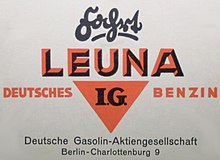Petrol
Motor gasoline or motor gasoline was in the 1930s until the end of World War II in the German Reich the term for motor gasoline lower knock resistance .
history

In order to reduce the dependence on foreign oil in Germany in the 1930s, which was poor in oil , and to use more domestic raw materials, the purchase ordinance for alcohol for fuel purposes came into force in 1930 for all fuel companies. 2.5 percent by weight of the amount of fuel produced or imported was to be obtained from the Reich monopoly administration and added to the petrol. This quota increased gradually to 10% by October 1932. The result was a gasoline normalized to a higher knock resistance through alcohol , which in the 1930s had an octane rating of 70 RON.
The most famous regular gasoline brands of the large petrol station companies were named in the 1930 standard ( Dapolin was founded in 1931 by the American German petroleum company renamed), there was Stellin ( Rhenania-Ossag ) Olexin ( OLEX ) and the synthetic "German petrol" Leuna petrol from the Leunawerke of IG Farben , distributed by Deutsche Gasolin . The Benzol Association now sold its Deron petrol . From the NITAG there was Nitalin . In addition, there were countless medium-sized mineral oil and petrol station companies, many of which merged in UNITI . At the Reichsautobahn-Fuel-GmbH the gasoline was simply called Reichsautobahnbenzin .
In Germany, car gasoline cost between 38 and 42 pfennigs per liter in 1935 and was set at 40 pfennigs in 1939.
At the same time, IG Farben increased the proportion of synthetic hydrogenation gasoline ( Leuna gasoline ) made from lignite more and more; from 1936 the first synthetic gasoline made from hard coal from the Scholven hydrogenation plant , which was also marketed by the Benzol Association as Leuna , was added. German gasoline production rose from around one to three million tons between 1935 and 1938.
In June 1938, Reich Minister of Transport Dorpmüller issued an order according to which only private vehicles were allowed whose engines could get by with 74 RON.
The normal gasoline from the beginning of 1939 for normal consumers became the two types of vehicle gasoline with an octane rating of 74 RON. Since there was no longer enough potato alcohol, Nordbenzin (or Fahrbenzin N ) was produced with an admixture of 13% of this alcohol and a little benzene. To the south of a line Elbe – Stade – Bremervörde – Soltau – Celle – Braunschweig – Berlin – Posen, Südbenzin (or Fahrbenzin S ) has been given the additive tetraethyl lead instead of alcohol to increase knock resistance .
With the changeover to the war economy in September 1939 and the associated central government control by the Mineral Oil Distribution Working Group (AMV), the brand names disappeared, and the petrol stations subordinate to the Central Office for Mineral Oil as a sales syndicate of the AMV only surrendered the fuel without a brand in return for a fuel ID card or a purchase voucher .
See also
literature
- Joachim Kleinmanns: Great, full! A brief cultural history of the gas station. Jonas Verlag, Marburg 2002, ISBN 3-89445-297-8 .
- Rainer Karlsch , Raymond G. Stokes: Factor Oil. The mineral oil industry in Germany 1859–1974. Verlag CH Beck, Munich 2003, ISBN 3-406-50276-8 .
Individual evidence
- ^ The time - economy: Federal Railways in the Defense, 1950.
- ^ Rainer Karlsch, Raymond G. Stokes: Factor oil. The mineral oil industry in Germany 1859–1974 . Verlag CH Beck, Munich 2003. ISBN 3-406-50276-8 , p. 200 f.
- ^ Fuels ( Memento from September 25, 2004 in the Internet Archive ).